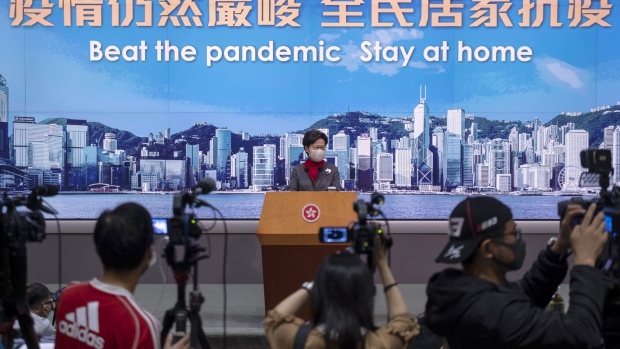Mar 2, 2022
Hong Kong Virus Fight Went From Confidence to Reliance on China
, Bloomberg News

(Bloomberg) -- When Hong Kong leader Carrie Lam announced that the Chinese government was bringing its mass-testing strategy to the city, a slogan behind her foreshadowed the move. “Combating the Epidemic with Staunch National Support,” it read.
Throughout the pandemic, the government has prominently displayed slogans at Lam’s news briefings to signal her government’s evolving Covid approach. But the sometimes awkward tag lines -- such as vowing to fight “the aggravating virus” -- have prompted ridicule. They’ve also provided a record of Hong Kong’s rocky path from early outbreak site to global safe haven to a place with one of the highest Covid death rates in the developed world.
From an early promise to battle “the virus with confidence” against a backdrop of blue skies, to trumpeting goals to “resume travel” and achieve “vaccination for all” that were never met, the slogans have recently grown more defensive. On Feb. 22 -- the last time Lam gave a major news conference -- Hong Kong signaled that Beijing’s help would be necessary to tip the balance. Her banner featured the central government’s emblem.
“These kind of slogans wish to convey a strong message that the government has not given up on the zero-tolerance policy mandated by the central government,” said Alex He, an associate professor at the Education University of Hong Kong who specializes in health policy and governance. “But the slogans themselves are empty, they barely tell us the principles or concrete messages.”
The Information Services Department didn’t respond to a request for comment on its process for crafting the messages.
Here’s how the slogans have changed:
“Fight the Virus Together with Confidence” (Aug. 21, 2020)
Eight months into the pandemic, and the city’s third wave had just started to subside after a voluntary universal testing program that mainland China had helped the city undertake. “This is a one-off exercise,” Lam said. Hong Kong officials said the city was taking early action to procure vaccines. In terms of making a down payment, officials said: “We do not have to worry about resources.”
- Daily cases: 27 (9 imported)
“Beat the Pandemic Stay at Home” (Nov. 30, 2020)
Back at the onset of the city’s long fourth wave, there were 520 Covid-19 cases linked to a dance club cluster. The government sought to keep residents at home by tightening social-distancing measures, including requiring masks at fitness centers and capping dining to two people per table. “To be fair to Hong Kong, we are not doing bad at all,” Lam said, citing the city’s low death rate compared to the U.K. and U.S.
- Daily cases: 76 (8 imported)
“A New Direction in Fighting the Pandemic” (April 12, 2021)
Vaccines arrived and Lam said she would reduce social-distancing measures for those inoculated and reduce quarantines for fully vaccinated individuals, with discussions underway for a much-anticipated travel bubble with Singapore that never materialized.
- Daily cases: 13 (11 imported)
“Early Vaccination for All” (June 21, 2021)
Hong Kong moved to partially relax Covid-19 controls for businesses and social activities after two weeks with zero local cases. Lam continued to encourage vaccinations, and said that vaccinated residents traveling back to the city who tested positive for antibodies could cut mandatory hotel quarantine to just 7 days from a 14 to 21 day range -- a reprieve that lasted some two weeks.
- Daily cases: 3 (3 imported)
“Building Double Barriers Against Covid-19” (Aug. 2, 2021)
The more-transmissible delta variant sweeps the world, seeing cases spike in Europe and the U.S. Hong Kong has recorded 56 days of zero local confirmed cases. Lam told reporters that there was “simply no room for complacency” that the whole community could be at risk if the city opened its borders. While the government stressed the need to increase vaccinations, no steps were taken to make vaccines mandatory.
- Daily cases: 3 (3 imported)
“Together, we fight the virus” (Jan. 5, 2022)
The city reverts to its original Covid slogan as omicron rewinds the clock on Hong Kong’s pandemic strategy. The city begins to impose strict social-distancing measures, after reporting its first untraceable local Covid-19 case in three months. A flight ban is invoked on eight countries, including France, the U.K. and the U.S., and dining after 6 p.m. is banned.
- Daily cases: 38 (34 imported)
“Fight the Virus Together to Resume Travel” (Jan. 14, 2022)
There were still hopes Hong Kong would open up its border with mainland China despite the emergence of omicron in the city. Lam told reporters the city was in a better situation compared to the fourth wave because of vaccination, and urged more vaccination ahead of a “vaccine bubble” for public venues.
- Daily cases: 9 (6 imported)
“Together, We Race Against the Aggravating Epidemic” (Feb. 4, 2022)
As Hong Kong began to see what Lam described as the worst outbreak in two years, her slogan featured a sense of urgency -- and awkward language. Hong Kong had announced an additional 130 locally transmitted Covid-19 cases and required residents at two housing estates to undergo centralized quarantine. Lam also said the city would buy tens of millions of home testing kits for its residents, as the number of invisible transmission chains grew.
- Daily cases: 131 (1 imported)
“Combating the Epidemic with Staunch National Support” (Feb. 22, 2022)
Lam announced that Hong Kong would initiate three rounds of mass testing for its 7.4 million residents over a three-month period, as the city announced more than 6,000 new confirmed cases, bringing a key mainland Chinese anti-pandemic tactic to the former British colony. President Xi Jinping described containment of the surging outbreak as an “overriding priority” for the city, and Beijing offered to build makeshift hospitals and send additional medical personnel to increase testing capacity.
- Daily cases: 6,211 (3 imported)
©2022 Bloomberg L.P.






